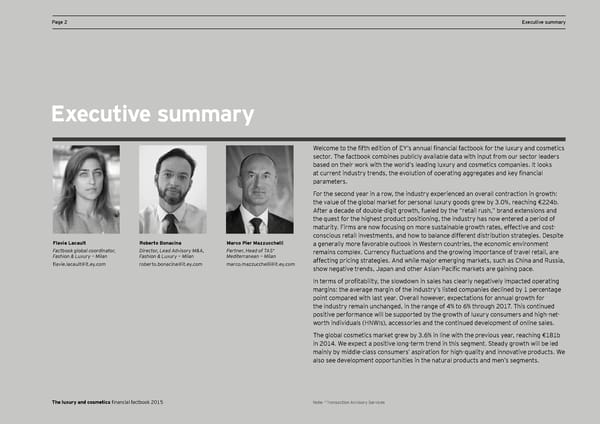Page 2 Executive summary Executive summary Welcome to the fifth edition of EY’s annual financial factbook for the luxury and cosmetics sector. The factbook combines publicly available data with input from our sector leaders based on their work with the world’s leading luxury and cosmetics companies. It looks at current industry trends, the evolution of operating aggregates and key financial parameters. For the second year in a row, the industry experienced an overall contraction in growth: the value of the global market for personal luxury goods grew by 3.0%, reaching €224b. After a decade of double-digit growth, fueled by the “retail rush,” brand extensions and the quest for the highest product positioning, the industry has now entered a period of maturity. Firms are now focusing on more sustainable growth rates, effective and cost- conscious retail investments, and how to balance different distribution strategies. Despite Flavie Lacault Roberto Bonacina Marco Pier Mazzucchelli a generally more favorable outlook in Western countries, the economic environment Factbook global coordinator, Director, Lead Advisory M&A, Partner, Head of TAS* remains complex. Currency fluctuations and the growing importance of travel retail, are Fashion & Luxury — Milan Fashion & Luxury — Milan Mediterranean — Milan affecting pricing strategies. And while major emerging markets, such as China and Russia, [email protected] [email protected] [email protected] show negative trends, Japan and other Asian-Pacific markets are gaining pace. In terms of profitability, the slowdown in sales has clearly negatively impacted operating margins: the average margin of the industry’s listed companies declined by 1 percentage point compared with last year. Overall however, expectations for annual growth for the industry remain unchanged, in the range of 4% to 6% through 2017. This continued positive performance will be supported by the growth of luxury consumers and high-net- worth individuals (HNWIs), accessories and the continued development of online sales. The global cosmetics market grew by 3.6% in line with the previous year, reaching €181b in 2014. We expect a positive long-term trend in this segment. Steady growth will be led mainly by middle-class consumers’ aspiration for high-quality and innovative products. We also see development opportunities in the natural products and men’s segments. The luxury and cosmetics financial factbook 2015 Note: *Transaction Advisory Services
 Seeking sustainable growth - The luxury and cosmetics financial factbook Page 3 Page 5
Seeking sustainable growth - The luxury and cosmetics financial factbook Page 3 Page 5